
Cape Elizabeth High School receives $10,000 to create training material “for educators focusing on LGBTQ+ knowledge and inclusion”; school district mandates that schools allow transgender students to use their preferred locker rooms and restrooms
Incidents
In 2022, the “It Gets Better Project” allowed schools to “apply for up to $10,000 in grant funding to support school-based projects empowering LGBTQ+ students.” The project was called “50 States. 50 Grants. 5000 Voices.” The organization specifically pointed out that “grant funding” even went to schools in “traditionally conservative areas.” Cape Elizabeth High School is a school that applied for a grant and received a full $10,000. The “It Gets Better Project” stated:
We are so excited to finally be able to announce all of the grant recipients, with each school receiving the full $10,000 in funding. Fifty grants are being awarded in 40 states plus Washington D.C., including many traditionally conservative areas. Submissions were received from a wide range of small rural towns, average-sized suburbs, and large urban cities.
The organization claimed that these grants were made available to schools thanks to the “generous support of American Eagle Outfitters, Inc. (AEO) through American Eagle and Aerie customer donations from all 50 states via their Real Rewards loyalty program, as well as in-store pin-pad promotion during Pride Month 2021.” In reference to Cape Elizabeth High School, the “It Gets Better Project” explained how the grant money will be used:
This project will assist the GSA in creating training materials for educators focusing on LGBTQ+ knowledge and inclusion. Trainings will include videos from students sharing the importance of each topic. This will ideally be shown school-wide at the start of each year.
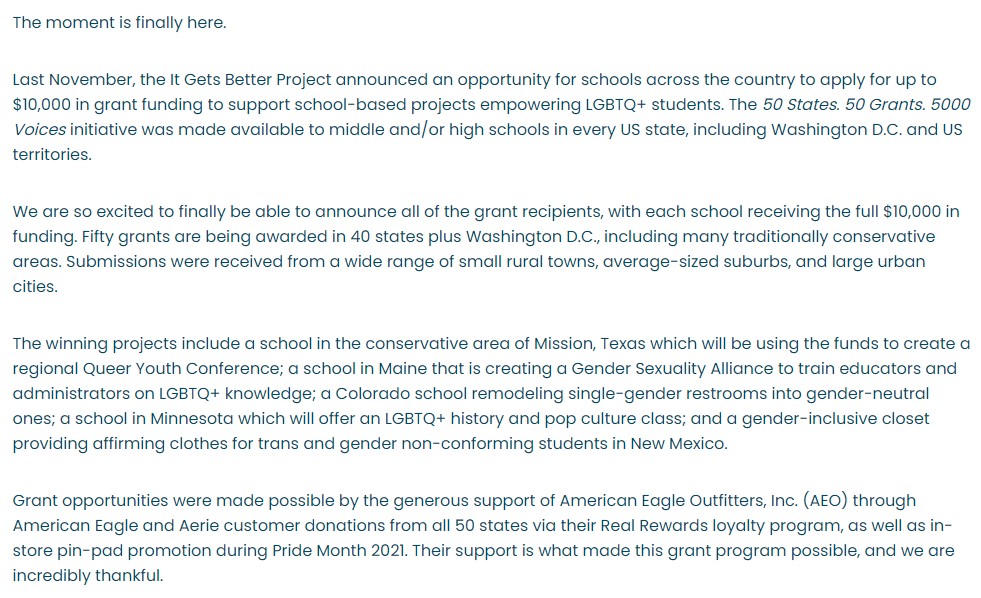

The “It Gets Better Project” is an organization that promotes LGBTQ issues to children. The organization states that its mission is “to uplift, empower, and connect lesbian, gay, bisexual, transgender, and queer (LGBTQ+) youth around the globe.” This includes through “storytelling and media.” The organization explains: “We work in all forms of media to bring messages of hope to LGBTQ+ youth, spark conversations about the challenges they confront, and inform and positively influence their sexual orientation and gender identity journey.”

On June 21, 2022, Cape Elizabeth’s official town website posted an article discussing how high school teacher and GSA club advisor Courtney Ferrell applied for the $10,000 grant with a student. The town’s website explains that the $10,000 will be used to create “a film that will educate teachers and students how to be more inclusive and use proper pronouns.” The article further explained: “The School Board unanimously approved the award during the June 14, 2022 meeting. Per Policy KCD: Public Gifts/Donations to the School, gifts and awards that are $10,000 or more must receive board approval.”

The school’s district – Cape Elizabeth School Department – has a policy titled “Transgender Students” that the district’s School Board passed on November 8, 2016. The policy explains that its purpose is “to assist in the educational and social integration of transgender students in our schools.” This policy includes the definitions of the terms “sexual orientation,” “gender identity,” “gender expression,” “transgender,” and “transition.” The policy describes “gender identity” as “a person’s deeply held sense or psychological knowledge of their own gender.” The policy describes “transition” as a “process by which a person goes from living and identifying as one gender to living and identifying as another.” This definition continues to explain: “For most elementary and secondary students, this involves no or minimal medical interventions.”
The policy also discusses creating a “plan” for transgender students in the district. When discussing the plan, the policy provides the following guidelines:
- A transgender student and/or their parent(s)/guardian(s) should contact the building administrator or the student’s guidance counselor. In the case of a student who has not yet enrolled in school, the appropriate building administrator should be contacted.
- A meeting should be scheduled to discuss the student’s particular circumstances and needs. In addition to the student, parent(s)/guardian(s) and building administrator, other participants may include the guidance counselor or social worker, school nurse, teachers, and/or other school staff, and possibly outside providers who can assist in developing a plan for that student.
- A plan should be developed by the school, in consultation with the student, parent(s)/guardian(s), and others as appropriate, to address the student’s particular needs. If the student has an IEP and/or a 504 plan, the provisions of these plans should be taken into consideration in developing the plan for addressing transgender issues.
- The school may request documentation from medical providers or other service providers as necessary to assist staff in developing a plan appropriate for the student.
- If the parties cannot reach an agreement about the elements to be included in the plan, the building administrator and/or Superintendent shall be consulted as appropriate.
The school district then provides guidelines for how the issue of transgender students should be handled while at school. These guidelines include mandating that all school staff and even students use the preferred pronouns of transgender students. Students can also use the restrooms and locker rooms that fit their preferred gender identity. School staff are additionally “expected to comply” with plans created for transgender students. The policy provides the following as guidelines for transgender students:
- Privacy: The student plan should address how to deal with disclosures that the student is transgender. In some cases, a student may want school staff and students to know, and in other cases the student may not want this information to be widely known. School staff should take care to follow the student’s plan and not to inadvertently disclose information that is intended to be kept private or that is protected from disclosure (such as confidential medical information). School Staff should keep in mind that under FERPA, student records may only be accessed and disclosed to staff with a legitimate educational interest in the information. Disclosures to others should only be made with appropriate authorization from the administration and/or parent(s)/guardian(s).
- Official Records: Schools are required to maintain a permanent record for each student that includes legal name and gender. This information is also required for standardized tests and official school unit reports. This official information will only be changed upon receipt of documentation that a student’s name or gender has been changed in accordance with any applicable laws. Any requests to change a student’s legal name or gender in official records should be referred to the Superintendent. To the extent that the school is not required to use a student’s legal name or gender on school records or other documents, the school should use the name and gender identified in the student’s plan.
- Names/Pronouns: A student who has been identified as transgender under these guidelines should be addressed by school staff and other students by the name and pronoun corresponding to their gender identity that is consistently asserted at school.
- Restrooms: A student who has been identified as transgender under these guidelines should be permitted to use the restroom assigned to the gender which the student consistently asserts at school. A transgender student who expresses a need for privacy will be provided with reasonable alternative facilities or accommodations such as using a separate stall or a staff facility. However, a student shall not be required to use a separate non communal facility over the student’s objection.
- Locker Rooms: The use of locker rooms requires schools to consider a number of factors, including but not necessarily limited to, the safety and comfort of students; the transgender student’s preference; student privacy; the ages of students; and available facilities. As a general rule, transgender students will be permitted to use the locker room assigned to the gender that the student consistently asserts at school. A transgender student will not be required to use a locker room that conflicts with the gender identity consistently asserted at school. A transgender student who expresses a need for privacy will be provided with reasonable alternative facilities or accommodations, such as using a separate stall, a staff facility, or separate schedule. Interscholastic athletic activities should be addressed through the Maine Principal’s Association Transgender Participation Policy.
- Other Gender-Segregated Facilities or Activities: As a general rule, in other facilities or activities when students may be separated by gender, transgender students may participate in accordance with the gender identity consistently asserted at school.
- Dress Code: Transgender students may dress in accordance with their consistently asserted gender identity, consistent with any applicable requirements in the dress code or school rules.
- Safety and Support for Transgender and Transitioning Students: School staff are expected to comply with any plan developed for a transgender student and to notify the building administrator or other designated support person for the student if there are concerns about the plan, or about the student’s safety or welfare. School staff should be sensitive to the fact that transgender and transitioning students may be at higher risk for being bullied or harassed, and should immediately notify the appropriate administrator if they become aware of a problem.
The policy then states that teachers may receive training “about transgender issues.” Teachers who are responsible for transgender students will also “receive support” to implement the plans of these students. The policy states:
- The Superintendent and/or building principal may institute in-service training and/or distribute educational materials about transgender issues to school staff as they deem appropriate.
- Teachers and other staff who have responsibilities for a transgender student with a plan will receive support in implementing the plan.
The school district’s website features a document titled “Model District Policy on Transgender and Gender Nonconforming Students” from the organization GLSEN. The document serves as a guide for schools to implement transgender policies. The document encourages schools to adopt policies that mandate using the preferred pronouns of students and allowing students to use their preferred restrooms and locker rooms. The document additionally encourages schools to adopt a policy that mandates school staff keep the gender identity of students a secret from parents. Some of the guidelines in the document appear similar to the school district’s policy on transgender students. GLSEN states in the document:
This document presents our Model District Policy on Transgender and Gender Nonconforming Students, which outlines best practices for schools to ensure that all students are safe, included and respected in school, regardless of their gender identity or expression — including transgender and gender nonconforming students.
The school district’s website additionally has a page titled “Student Project on Mental Health.” The district explains that the page is “designed and submitted by a student at Cape Elizabeth.” The district further explains that this page’s “content has been vetted by Cape Elizabeth School Department (CESD) health, administrative, and athletic staff.” The page is described as having “mental health resources.” One section of resources is titled “Mental Health in the LGBTQ+ Community.”

The LGBTQ resource section asks the question: “What is gender?” It then links to an article from the University of North Carolina at Chapel Hill titled “Getting they/them pronouns right.” The article quotes “UNC-Chapel Hill professor of psychology and neuroscience” Jennifer Arnold in supporting using the pronouns “they/them” to refer to one person: “Announcing one’s pronouns matters, and explicitly saying that someone uses they/them pronouns increases the chance that others will successfully interpret the pronoun in this way in the future.”
The school district’s LGBTQ resources also include a list of pronouns. These are:
- he/him/his
- she/her/hers
- they/them/theirs
- she/they or he/they
- Neopronouns
- Just my name, please!


The school district then provides additional links to organizations that provide gender transitioning services to young children. One resource is titled “Gender Clinic at Barbara Bush Children’s Hospital.” This hospital lists “menstrual suppression (stopping unwanted periods),” “puberty blockers (ways to stop puberty hormones),” “gender affirming hormone therapy (estrogen or testosterone),” and “surgical consultation (mental health letter of referral)” as services for “youth.”
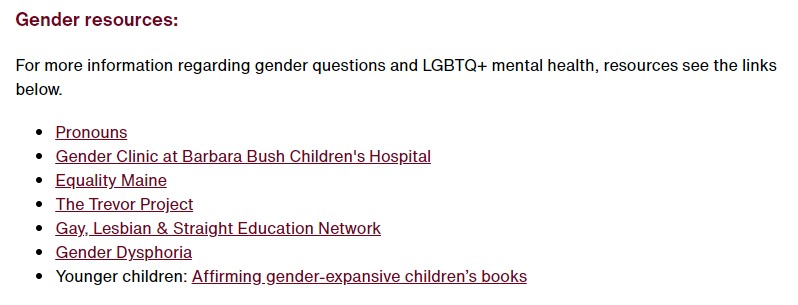
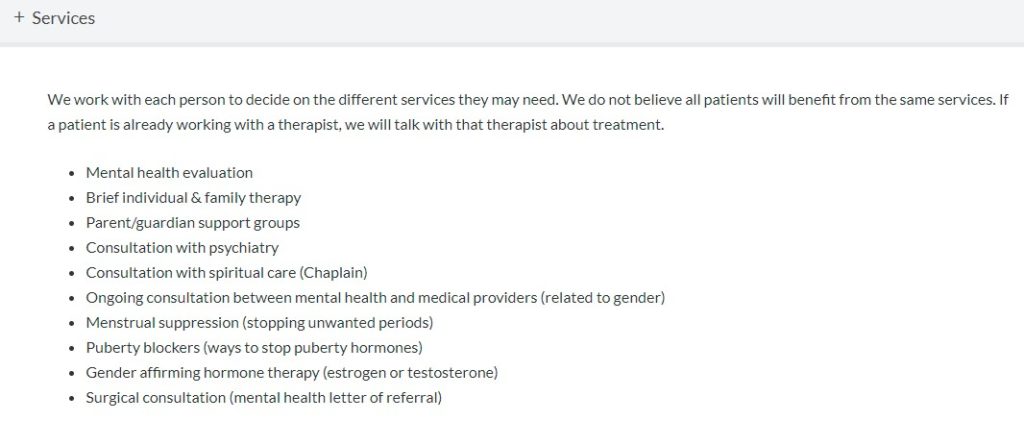
An additional resource that the school district links to is GLSEN. The organization GLSEN is known for promoting LGBTQ issues to young children. GLSEN states on its website that “while many LGBTQ+-inclusive school supports begin in middle or high school, it is critical for elementary schools to establish a foundation of respect and understanding for all people.” The organization has also appeared to show support for children taking “hormone replacement therapy” to transition to another gender:
Upon birth, we are typically categorized into one of two genders (boy or girl) depending on how our genitals are read. Throughout our lives, however, our many bodily characteristics work together to create a unique path of development, causing some of us to grow really tall, and others to remain short, or some of us to grow hair under our armpits and legs, while others remain bare. While this development often happens on its own during puberty, this change can also be administered through medicine, such as hormone replacement therapy. Since our society often conflates our bodies (or genitalia) with our gender identity, it is critical that we allow space for people to self-identify.


The school district also provides a resource titled “Younger children: Affirming gender-expansive children’s books.” This resource states: “Kids need to see their identities reflected in the world. For kids and caregivers looking for ways to understand their own gender identities, as well as others’, books can be a helpful starting point. Share these affirming, gender-expansive books with the kids in your life.” This resource is a list of books promoting the idea to children that people can transition to another gender.
The books on this list include When Aidan Became a Brother and My Maddy. The book When Aidan Became a Brother is about a young girl who transitions to being a boy. The resource describes the book My Maddy as: “A child celebrates her Maddy, who is neither mommy nor daddy but a little bit of both, like so many things in nature.” Additional books on this list include You Be You!: The Kid’s Guide to Gender, Sexuality, and Family, The Gender Wheel, and Who Are You?: The Kid’s Guide to Gender Identity.
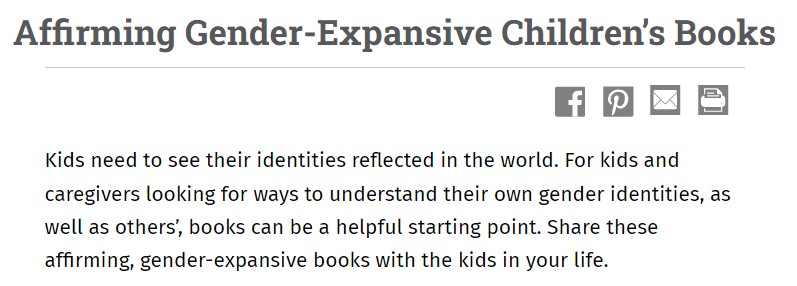
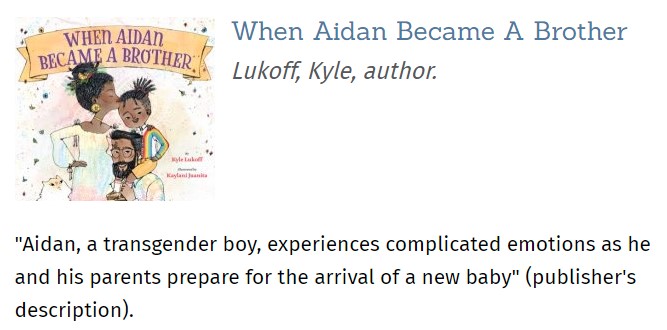
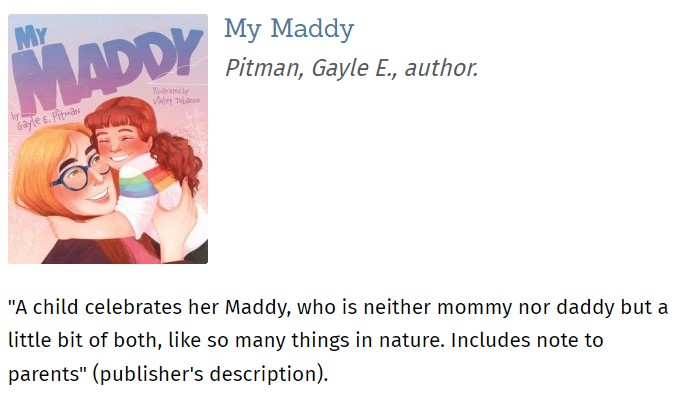
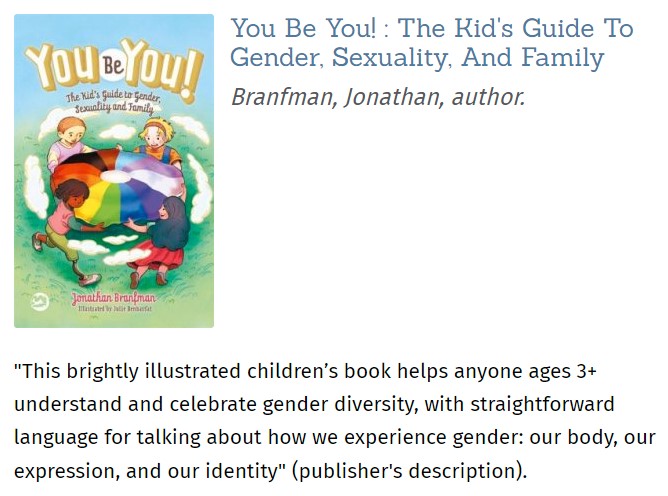

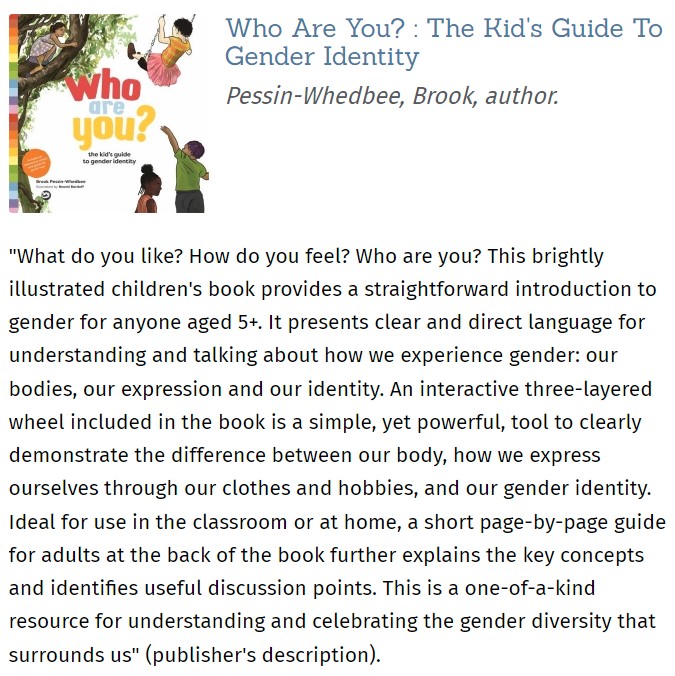
Stay Informed
